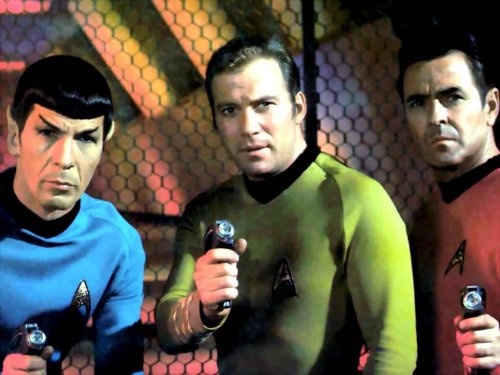Advances in TREKnology

In September of 1966, the NBC television network released an iconic but short lived series that would inspire generations of inventors to bring about changes in our daily lives in the use of technology that many of us take for granted but was once within the realms of strictly Science Fiction.
The original series, based on a "Wagon train to the Stars" Western turned Sci-Fi adventure concept envisioned by Gene Roddenberry, Dorothy C. Fontana and Matt Jeffries which ran for a total of 3 seasons from 1966 to 1969 is the basis for the feature film prequel/remake which is being released this weekend, nearly 43 years later.
In the span of those four decades, many of the gadgets and technologies showcased in STAR TREK and in the revival shows and feature films which followed it in the 1980s, 1990s and the 2000s did eventually come to fruition.
Click on the "Read the rest of this entry" link below for more.
Communications Technology
Today flip-style cell phones which look like the original Communicator have largely given way to more powerful touchscreen smartphones like the iPhone and BlackBerry Storm, but without STAR TREK we probably wouldn't have seen either of them.
The true Communicator didn't use cell towers -- it was able to broadcast over huge distances and allow crew members to communicate planet-wide and to the ship in orbit without the use of any support infrastructure. We haven't gotten there yet, and we sort of failed with mass adoption of global-capable Communicator tech with Iridium, but modern cell phones do permeate our lives and we do have the ability now to locate each other with built-in
Recently, Google introduced the Latitude service which allows anyone carrying a GPS-capable cell phone to be visually located by their friends, so we're getting closer to the "True" TREK Communicator.
The Cell/Mobile Phone was not the only aspect of Trek communications technology which made it to reality. The wireless earpiece, which both Communications Officer Lt. Uhura and Science Officer Spock were known to have used on a number of occasions on the show also became reality as the Bluetooth Headset, also a Motorola innovation.
Information Technology
My favorite of these display technologies is the PADD, or the Personal Access Display Device. Although the term was coined later in 1987 with the release of the Star Trek: The Next Generation series it did actually make an appearance a few times in the original show, where it was used by various
Today, aspects of the PADD can be found in many forms of handheld touch screen, MIDs and tablet devices, including the iPod Touch, the BlackBerry Storm, the T-Mobile G1 and the upcoming Palm Pre. Larger format PADD-like devices such as e-book readers like the Kindles, the Sony PRS-700BC,UMPCsand Tablet PCs haven't taken off in tremendous volumes yet, largely due to cost and the current economy, but they are definitely a product of STAR TREK. [UPDATE: Apple released the 10" inch iPad in April of 2010, making the "PADD" a reality].
In addition to advanced display technology, Human/Computer voice interaction as featured on the various STAR TREK series has also been implemented in various forms. While most of us do not interact with our computers by talking, voice dictation using products such as Dragon Naturallyspeaking and IBM Via Voice allow for limited and specialized application by using voice commands and voice dictation.
"Expert"
STAR TREK's "Memory Bank" technology which enabled the crew and various alien civilizations to record and play back music and video in digital form has also made its appearance as some of the most popular consumer electronic devices in the world -- as iPods, Portable Media Players and Digital Video Recorders, as well as SecureDigital and CompactFlash memory storage cards and the latest Solid State Disk drives.
Medical Technology
The "Sickbay" on the Enterprise was a medical science marvel, filled with all sorts of fantastic tools with the capability to diagnose virtually any ailment in existence and perform complex surgeries on life-threatened patients with virtually no blood spilled. While we've got a long way to go until we get the full set of medical tools that was available to Dr. McCoy, quite a few of TREK's medical gizmos have left it's influence on real life healthcare technology.One of those is the LifeBed, which is a near-dead ringer for Dr. Mccoy's sickbay. Similar diagnostic equipment has been used aboard the International Space Station and in mobile field hospitals in the military. Naturally, advanced medical imaging technologies inspired by the original series and Next Generation sickbays made their way into CT and MRI equipment, which are a staple of modern medical diagnostics.
Mccoy's "Hypospray" which allowed for instantaneous, bloodless and needle-free liquid injections hasn't quite made it in terms of handheld portability yet to every medical office, but a real-life equivalent for use in mass-dosage scenarios exists as the Jet Injector and is used for vaccinations by the Department of Defense and other government and relief agencies around the world.
While the truly non-invasive surgery employed on the original Star Trek and TNG shows for generalized use still remain largely Science Fiction, some procedures such as Stereotactic Radiosurgery for treating specific types of tumors allow for non-invasive surgery on brain tissue using focused radiation beams.
And while the hand held directed energy "Phaser" guns used for combat against hostile aliens still remain a fantasy, LASIK surgery using focused low-wattage lasers to correct vision is now well on its way to making eye glasses and contact lenses obsolete.
Is there a favorite real-world STAR TREK technology that I've managed to leave out? Talk Back and Let Me Know.
